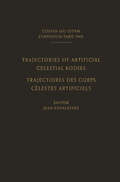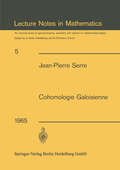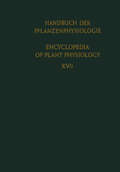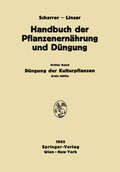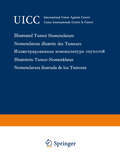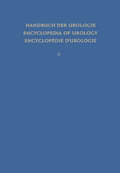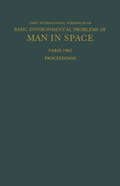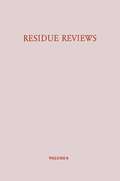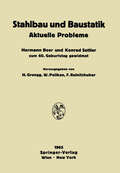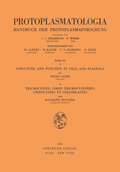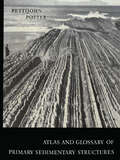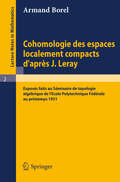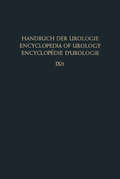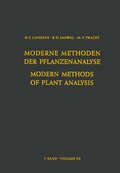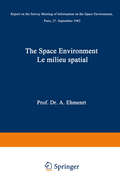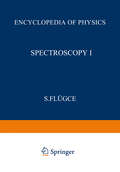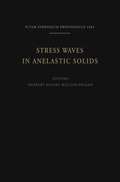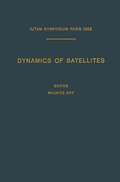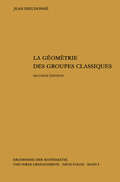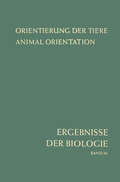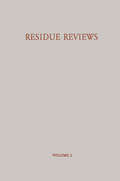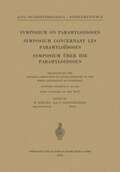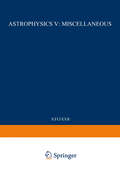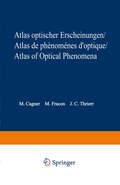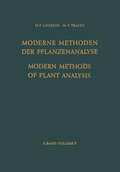- Table View
- List View
Trajectories of Artificial Celestial Bodies as Determined from Observations / Trajectoires des Corps Celestes Artificiels Déterminées D’après les Observations: Proceedings of a Symposium Held in Paris, April 20–23, 1965
by J. KovalevskyIn May 1962 the International Union of Theoretical and Applied Mechanics (IUTAM) organized a symposium in Paris on the theory of the movement of the Earth's artificial satellites designated to confront the results of the first spatial experiences with the mechanical point of view. The papers submitted during this meeting have been published in 1963 in a collection entitled "Dynamics of Satellites" by Springer Verlag. During the last three years the importance of studies pertaining to the dynamics of artificial satellites has continued to increase, and many results due to observations have led to a deeper knowledge of the field of forces in which these objects move, particularly the field of gravitation of the Earth, the forces due to pressure of radiation, friction of the atmosphere, etc . . . A new symposium seemed therefore suitable to determine these recent advances. However, this time it appeared appropriate to consider it more from the point of view of the interpretation obtained from the results of observations (determination of orbits and forces existing) than from the point of view of the theory of motion. For this reason the complete title of the second symposium is as follows: "Trajectories of Artificial Celestial Bodies, as Determined from Observations".
Cohomologie Galoisienne: Cours au College de France, 1962-1963 (Lecture Notes in Mathematics #5)
by Jean-Pierre SerreDifferenzierung und Entwicklung / Differentiation and Development (Handbuch der Pflanzenphysiologie Encyclopedia of Plant Physiology #15)
by A. LangDüngung der Kulturpflanzen: Erste Hälfte (Handbuch der Pflanzenernährung und Düngung #3 / 1)
by N. Atanasiu W. Baden F. Baltin L. D. Baver A. Blamauer E. v. Boguslawski K. Bräunlich D. Brüning Y. Coïc Diplomgärtnerin Liselotte Forchthammer W. Frohner A. Fruhstorfer L. Gisiger M. Gökgöl W. Gruppe C. Heinemann W. Jahn-Deesbach J. Jung E. Klapp L. M. Kopetz H. Kraut P. W. Kürten H. Linser H. Löcker H. Lüdecke Direktor F. Mappes A. v. Müller W. Müller K. Nehring K.-H. Neumann F. Penningsfeld Edith Primost H. Rüther K. Schmid H. Schröder W. Schuster O. Siegel O. Steineck R. Steiner V. Tay?i H. Will W. Wirths F. ZattlerSeit dem Erscheinen des zweibändigen Standardwerkes von F. HONCAMP, "Handbuch der Pflanzenernährung und Düngerlehre", sind mehr als dreißig Jahre vergangen. Bei den stürmischen Fortschritten auf allen Gebieten der Natur wissenschaften, insbesondere der Chemie, Pflanzenphysiologie, Biochemie, Bodenkunde und Technologie, ist dieses zur Zeit seines Erscheinens so aus gezeichnete Handbuch natürlich längst veraltet. Zweifellos besteht heute ein dringendes Bedürfnis nach einem ähnlichen Werk. Wenn wir von dem ursprünglichen Plan abgekommen sind, das HONCAMP sche Handbuch in neuer Auflage zu bearbeiten, so vor allem deswegen, weil die tiefgreifende Entwicklung auf diesem Gebiet eine völlig neue Gestaltung des Werkes geboten erscheinen ließ. Es gliedert sich nun in drei Bände. Band I behandelt im wesentlichen die physiologischen Grundlagen der Pflanzenernährung. Er enthält eine ausführliche und systematische Darstellung der eigentlichen Ernährungsphysiologie. Auf eine Erörterung der allgemeinen pflanzen physiologischen Grundlagen konnte dabei verzichtet werden, weil im RUHLAND sehen "Handbuch der Pflanzenphysiologie" ein umfassendes und modernes Nach schlagewerk zur Verfügung steht. Band II beschäftigt sich mit dem Boden und den Düngemitteln. Unter Berücksichtigung der modernen Agrikulturchemie haben wir das heutige Wissen über den Boden als Standort und Nährstoffquelle der Pflanze unter den Verhält nissen der landwirtschaftlichen Praxis und des Gartenbaues bzw. des Forstwesens systematisch zusammengefaßt. Die folgenden Kapitel befassen sich mit der Beschreibung und Herstellung der verschiedenen Wirtschafts- und Handels düngemittel. Gerade auf diesem Gebiet bestehen in der wissenschaftlichen Literatur erhebliche Lücken, da keine größeren Lehr-oder Handbücher vorhanden sind, die sich eingehender mit der Technologie der Düngemittel und der Düngung beschäftigen.
Physiologie und Pathologische Physiologie / Physiology and Pathological Physiology / Physiologie Normale et Pathologique (Handbuch der Urologie Encyclopedia of Urology Encyclopedie d'Urologie #2)
by B. Fey F. Heni A. Kuntz D. F. McDonald L. Quenu L. G. Wesson C. WilsonProceedings of the First International Symposium on Basic Environmental Problems of Man in Space: Paris, 29 October — 2 November 1962
by Hilding BjurstedtThis volume contains the communications and discussions of the First Inter national Symposium on Basic Environmental Problems of Man in Space, which was held 29 October - 2 November 1962 at Unesco House, Paris, under the joint sponsorship of the International Astronautical Federation (IAF) and the International Academy of Astronautics (IAA) with the cooperation and support of Unesco, the International Atomic Energy Agency (IAEA) and the World Health Organization (WHO). At this Symposium 31 communications were presented, 8 of which were from the USSR, 8 from the USA, and 15 from other countries, all by special invitation. The presentations, which included three general review papers, were made in ten half-day working sessions by a distinguished international group. The pro ceedings were not restricted to the acute professional aspects of man in space. In fact, the majority of the vast store of material contained in this volume deals with the more scientific aspects, i. e. with problems of the future, which are con tributed mainly by conventional areas of physiology and psychophysiology, including the technical research activities pertaining to the acquisition, analysis and control of biomedical data.
Residue Reviews / Rückstands-Berichte: Residues of Pesticides and other Foreign Chemicals in Foods and Feeds / Rückstände von Pesticiden und Anderen Fremdstoffen in Nahrungs- und Futtermitteln (Residue Reviews/rückstandsberichte Ser. #8)
by Francis A. GuntherThat residues of pesticide and other "foreign" chemicals in foodstuffs are of concern to everyone everywhere is amply attested by the reception accorded previous volumes of "Residue Reviews" and by the gratifying enthusiasm, sincerity, and efforts shown by all the individuals from whom manuscripts have been solicited. Despite much propaganda to the contrary, there can never be any serious question that pest-control chemicals and food additive chemicals are essential to adequate food production, manufacture, marketing, and storage, yet without continuing surveillance and intelligent control some of those that persist in our foodstuffs could at times conceivably endanger the public health. Ensuring safety-in-use of these many chemicals is a dynamic challenge, for established ones are continually being displaced by newly developed ones more acceptable to food technologists, pharma cologists, toxicologists, and changing pest-control requirements in progressive food-producing economies. These matters are also of genuine concern to increasing numbers of governmental agencies and legislative bodies around the world, for some of these chemicals have resulted in a few mishaps from improper use. Adequate safety-in-use evaluations of any of these chemicals persisting into our food stuffs are not simple matters, and they incorporate the considered judgments of many individuals highly trained in a variety of complex biological, chemical, food technological, medical, pharmacological, and toxicological disciplines.
Stahlbau und Baustatik: Aktuelle Probleme
by Hermann Grengg Walter Pelikan F. ReinitzhuberHermann Beer und Konrad Sattler zum 60. Geburtstag gewidmet
Structure and Function in Cilia and Flagella / Trichocystes, Corps Trichocystoïdes, Cnidocystes et Colloblastes (Protoplasmatologia Cell Biology Monographs #3 / E,F)
by Peter Satir Raymond HovasseAtlas and Glossary of Primary Sedimentary Structures
by F. J. Pettijohn P. E. PotterInadequate observation of sedimentary TRUSHKovA and KUKHARENKO'S "Atlas of structures has been responsible for incorrect Placer Minerals." The most comprehensive interpretation of the order of superposition atlas is the "Atlas of Textures and Struc in deformed beds and this has led, in turn, tures of Sedimentary Rocks" edited by A. to gross errors in stratigraphy and structure. V. KHABAKOV (1962). Failure to recognize and utilize those Our Atlas is an outgrowth of our work on structures which indicate direction of cur "Paleocurrents and Basin Analysis," a book rent flow has also led to incorrect, or at in which directional sedimentary structures least incomplete, understanding of basin are described and interpreted with special development. reference to the evolution of sedimentary We believe, therefore, that there is need for basins. That work, however, contains mini a work which constitutes a field guide to the mal photographic material - just enough study of these structures - a book in to give the reader some concept of the sedi which these structures, so difficult to mentary structures described.
Cohomologie des espaces localement compacts d'apres J. Leray: Exposes faits au Seminaire de topologie algebrique de l'Ecole polytechnique federale au printemps 1951 (Lecture Notes in Mathematics #2)
by Armand BorelEntzündung I / Inflammation I: Unspezifische Entzündungen / Non-specific Inflammations / Inflammations Non-Spécifiques (Handbuch der Urologie Encyclopedia of Urology Encyclopedie d'Urologie #9 / 1)
by G. Bickel H. Dettmar W. von Niederhäusern V. J. O'Connor F. Schaffhauser E. Wiesmann E. Wildbolz H. U. ZollingerVon E. WILDBOLZ In den letzten Jahren ist die Pyelonephritis, vor allem die chronische Pyelo nephritis, immer mehr in den Brennpunkt des medizinischen Interesses gerückt. Klinische und anatomische Arbeiten zeigen ihr außerordentlich häufiges Vor kommen. Sie ist heute die bedeutendste Gruppe der Nierenerkrankungen, ja sie hat sogar die Infektionen der Atemorgane von ihrem ersten Rang in der Häufigkeitsskala aller Infektionskrankheiten bei Spitalpatienten verdrängt. Auch der langsam Reagierende muß sich Rechenschaft davon ablegen, daß hinter der harmlosen Etikette einer chronischen Pyurie, einer chronischen Cystitis, einer Cystopyelitis, einer "empfindlichen Blase" sich oft eine Erkrankung verbirgt, die sich über Jahrzehnte hinzieht, progredient ist und schließlich, aller Therapie trotzend, zum Tode führt. Die pyelonephritische Schrumpfniere übertrifft an Zahl bei weitem alle anderen Schrumpfnieren. Diese Untersuchungen haben ferner ergeben, daß die atypischen Formen der chronischen Pyelonephritis ebenso häufig wie die typischen Formen sind, bei denen die chronische Pyurie auf den Ursprung der Erkrankung hinweist. Wir müssen also nicht nur diese Pyurien richtig deuten und auslegen, sondern wir müssen auch bei Erkrankungen wie Anämie, Adynamie, Neurose, an den renalen Ursprung der Allgemeinstörungen denken. Durch alle Studien, die sich etwas ausführlicher und eingehender mit der Klinik der chronischen Pyelonephritis befassen, zieht sich wie ein roter Faden die Verzweiflung über die Ohnmacht unserer Therapie. Die Therapie mit Anti biotica, die in akuten Fällen so viel Gutes zeitigt und die bei ihrer Einführung die Ausmerzung aller Infektionskrankheiten erwarten ließ, versagt.
Modern Methods of Plant Analysis / Moderne Methoden der Pflanzenanalyse (Modern Methods of Plant Analysis Moderne Methoden der Pflanzenanalyse #7)
by Israel ArnonThe Space Environment / Le Milieu Spatial: Report on the Survey Meeting of Information on the Space Environment Paris, 27 September 1963
by Alfred EhmertOrganized by the International Academy of Astronautics and the International Astronautical Federation with the Support and Cooperation of UNESCO and the Scientific Cooperation of COSPAR
Stress Waves in Anelastic Solids: Symposium Held at Brown University, Providence, R. I., April 3–5, 1963 (IUTAM Symposia)
by Herbert Kolsky William PragerAlthough the subject of wave propagation in solids has a long history, the classical theory of elastic waves having been developed in the nine teenth century by STOKES, POISSON, RAYLEIGH and KELVIN, the last two decades have seen a remarkable revival of interest in this subject among both theoreticians and experimenters. There' are a number of reasons for this; first, experimental methods for the generation and detection of high frequency mechanical waves have become available only with the advent of electronic techniques and of high speed photo graphic recording apparatus. Secondly, the appearan
Dynamics of Satellites / Dynamique des Satellites: Symposium Paris, May 28–30, 1962 / Symposium Paris, 28–30 Mai 1962 (IUTAM Symposia)
by Maurice RoyLa geometrie des groupes classiques: Reihe: Gruppentheorie (Ergebnisse der Mathematik und ihrer Grenzgebiete. 2. Folge #5)
by Jean DieudonneThis book gives an excellent survey of recent work on classical groups, simplifying and unifying the results of many authors. No attempt is made to cover all of the voluminous literature on classical groups; the author deals with only that portion of the subject which can be handled by the methods of linear algebra. By thus restricting his scope, he is able to include proofs of most of the results described, thereby making the book more self-contained than most Ergebnisse tracts.In the reviewer's opinion, this is an important and well-written book which should help to stimulate research on the classical groups. The book not only gives a thorough exposition of the present state of the subject, but is also an excellent introduction to the modern techniques basic to further work in this field.
Orientierung der Tiere / Animal Orientation: Symposium in Garmisch-Partenkirchen 17.–21. 9. 1962 (Ergebnisse der Biologie Advances in Biology #26)
by Hansjochem Autrum Erwin Bünning Karl v. Frisch E. Hadorn A. Kühn E. Mayr A. Pirson J. Straub H. Stubbe W. WeidelResidue Reviews / Rückstands-Berichte: Residues of Pesticides and Other Foreign Chemicals in Foods and Feeds / Rückstände von Pesticiden und Anderen Fremdstoffen in Nahrungs- und Futtermitteln (Reviews of Environmental Contamination and Toxicology #2)
by Francis A. GuntherResidues of pesticides and other "foreign" chemicals in foodstuffs are of concern to everyone everywhere; they are essential to food production and manufacture, yet without surveillance and intelligent control some of those that persist could at times conceivably endanger the public health. The object of "Residue Reviews" is to provide concise, critical reviews of timely advances, philosophy, and significant areas of accomplished or needed endeavor in the total field of residues of these chemicals in foods, in feeds, and in transformed food products. These reviews are either general or specific, but properly they may lie in the domains of analytical chemistry and its methodology, biochemistry, human and animal medicine, legislation, pharmacology, physiology, regulation, and toxicology; certain affairs in the realm of food technology that are concerned specifically with pesticide and other food-additive problems are also appropriate subject matter. The justification for the preparation of any review for this book series is that it deals with some aspect of the many real problems arising from the presence of residues of foreign chemicals in foodstuffs. The scope of "Residue Reviews" is international. It encompasses those matters, in any country, which are involved in allowing pesticide and other plant-protecting chemicals to be used safely in producing, storing, and shipping crops. Added plant or animal pest-control chemicals or their metabolites that may persist into meat and other edible animal products (milk and milk products, eggs, etc.
Symposium on Paramyloidoses / Symposium Concernant les Paramyloïdoses / Symposium über die Paramyloidosen: Organized by the Problem Commission of Neurochemistry of the World Federation of Neurology Antwerp, October 30–31, 1960 (Acta Neuropathologica Supplementa #2)
by W. Krücke F. SeitelbergerAstrophysics V: Miscellaneous / Astrophysik V: Verschiedenes (Handbuch der Physik Encyclopedia of Physics #11 / 54)
by S. FlüggeAtlas optischer Erscheinungen / Atlas de phénomènes d’optique / Atlas of optical phenomena
by Michel Cagnet M. Francon J.C. ThrierrModern Methods of Plant Analysis / Moderne Methoden der Pflanzenanalyse (Modern Methods of Plant Analysis Moderne Methoden der Pflanzenanalyse #5)
by K. Biemann N. K. Boardman B. Breyer S. P. Burg W. L. Butler D. J. David P. S. Davis A. E. Dimond A. C. Hildebrandt F. A. Hommes O. Kratky H. F. Linskens H. Moor K. H. Norris I. J. O'Donnell J. V. Possingham H. Prat D. H. Slogteren E. Stahl J. A. Veken J. P. Want E. F. Woods123 phase and hence have no direct bearing on the retention time of solutes. However in gas-solid chromatography, a considerable quantity of the mobile phase may be adsorbed on the surface of the stationary adsorbent which diminishes the column's effective length and ability to retain solutes. In this respect helium has been found to be preferable to most other gases (GREENE and Roy, 1957) because it is adsorbed to the least extent. 3. Packed columns offer a considerable resistance to flow, which may create a pressure differential between inlet and outlet of sufficient magnitude to cause an unfavorable flow rate through a significant length of the column. A reduced inlet/outlet pressure ratio can be obtained by using light molecular weight gases toward which the column packing shows the greatest permeability. The flow rate of the mobile phase is normally adjusted by altering the column inlet pressure, for which purpose commercial pressure regulators of sufficient accuracy are available. Quantitative measurements of the flow rate can be made by a number of methods, including rotameters, orifice meters, soapfilm flow meters and displacement of water. The former two methods are the most con venient but the least accurate; moreover they create a back pressure and are temperature dependent whereas although the moving soap bubble is cumbersome to employ and unusable for continuous readings, it is preferred when the highest accuracy is required.
